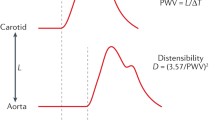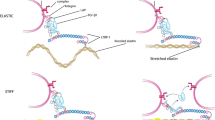Abstract
Numerous studies performed in the past decade have shown that increased pulse pressure, an indicator of arterial stiffening, is associated with adverse clinical outcomes. Research is now focused on better defining the anatomic and physiologic determinants of increased pulse pressure. Early work considered aortic stiffening to be a passive, irreversible consequence of aging that was accelerated by hypertension. Recent studies suggest that aortic stiffening is dynamic and reversible and that abnormalities in aortic function may play a primary role in the pathogenesis of hypertension. This review summarizes current work on the genesis of increased pulse pressure and abnormal pulsatile load in hypertension, and underscores areas for future research.
Similar content being viewed by others
References and Recommended Reading
Darne B, Girerd X, Safar M, et al.: Pulsatile versus steady component of blood pressure: a cross-sectional analysis and a prospective analysis on cardiovascular mortality. Hypertension 1989, 13:392–400.
Madhavan S, Ooi WL, Cohen H, Alderman MH: Relation of pulse pressure and blood pressure reduction to the incidence of myocardial infarction. Hypertension 1994, 23:395–401.
Mitchell GF, Moye LA, Braunwald E, et al.: Sphygmomanometrically determined pulse pressure is a powerful independent predictor of recurrent events after myocardial infarction in patients with impaired left ventricular function. SAVE investigators. Survival and Ventricular Enlargement. Circulation 1997, 96:4254–4260.
Domanski MJ, Davis BR, Pfeffer MA, et al.: Isolated systolic hypertension: prognostic information provided by pulse pressure. Hypertension 1999, 34:375–380.
Domanski M, Norman J, Wolz M, et al.: Cardiovascular risk assessment using pulse pressure in the first national health and nutrition examination survey (NHANES I). Hypertension 2001, 38:793–797.
Domanski M, Mitchell G, Pfeffer M, et al.: Pulse pressure and cardiovascular disease-related mortality: follow-up study of the Multiple Risk Factor Intervention Trial (MRFIT). JAMA 2002, 287:2677–2683.
Laurent S, Boutouyrie P, Asmar R, et al.: Aortic stiffness is an independent predictor of all-cause and cardiovascular mortality in hypertensive patients. Hypertension 2001, 37:1236–1241. This study showed that CFPWV predicts increased risk for an adverse clinical outcome in hypertensives.
Laurent S, Katsahian S, Fassot C, et al.: Aortic stiffness is an independent predictor of fatal stroke in essential hypertension. Stroke 2003, 34:1203–1206.
Mitchell GF, Parise H, Benjamin EJ, et al.: Changes in arterial stiffness and wave reflection with advancing age in healthy men and women: the Framingham Heart Study. Hypertension 2004, 43:1239–1245. This study evaluated changes in regional arterial stiffness with advancing age in a healthy, community-based sample and showed that aortic stiffness and forward-wave amplitude, rather than reflected-wave amplitude, contribute to increasing CPP with advancing age.
Safar ME, Levy BI, Struijker-Boudier H: Current perspectives on arterial stiffness and pulse pressure in hypertension and cardiovascular diseases. Circulation 2003, 107:2864–2869.
Kelly R, Hayward C, Avolio A, O’Rourke M: Noninvasive determination of age-related changes in the human arterial pulse. Circulation 1989, 80:1652–1659.
Kelly R, Fitchett D: Noninvasive determination of aortic input impedance and external left ventricular power output: a validation and repeatability study of a new technique. J Am Coll Cardiol 1992, 20:952–963.
Mitchell GF, Tardif JC, Arnold JM, et al.: Pulsatile hemodynamics in congestive heart failure. Hypertension 2001, 38:1433–1439.
Mitchell GF, Izzo JL Jr, Lacourciere Y, et al.: Omapatrilat reduces pulse pressure and proximal aortic stiffness in patients with systolic hypertension: results of the conduit hemodynamics of omapatrilat international research study. Circulation 2002, 105:2955–2961. Demonstrated that central aortic stiffness is modifiable in middleaged and elderly individuals with established systolic hypertension.
Mitchell GF, Pfeffer MA, Finn PV, Pfeffer JM: Equipotent antihypertensive agents variously affect pulsatile hemodynamics and regression of cardiac hypertrophy in spontaneously hypertensive rats. Circulation 1996, 94:2923–2929.
Mitchell GF, Lacourciere Y, Ouellet JP, et al.: Determinants of elevated pulse pressure in middle-aged and older subjects with uncomplicated systolic hypertension: the role of proximal aortic diameter and the aortic pressure-flow relationship. Circulation 2003, 108:1592–1598. Determinants of increased pulse pressure in hypertension were evaluated, and it was demonstrated that reduced aortic diameter may play an important role in the genesis of elevated pulse pressure in hypertensives.
van der Heijden-Spek JJ, Staessen JA, Fagard RH, et al.: Effect of age on brachial artery wall properties differs from the aorta and is gender dependent: a population study. Hypertension 2000, 35:637–642.
Benetos A, Laurent S, Hoeks AP, et al.: Arterial alterations with aging and high blood pressure: a noninvasive study of carotid and femoral arteries. Arterioscler Thromb 1993, 13:90–97.
Boutouyrie P, Laurent S, Benetos A, et al.: Opposing effects of aging on distal and proximal large arteries in hypertensives. J Hypertens Suppl 1992, 10:S87-S91.
Hayoz D, Rutschmann B, Perret F, et al.: Conduit artery compliance and distensibility are not necessarily reduced in hypertension. Hypertension 1992, 20:1–6.
Quick CM, Berger DS, Noordergraaf A: Apparent arterial compliance. Am J Physiol 1998, 274:H1393-H1403.
Murgo JP, Westerhof N, Giolma JP, Altobelli SA: Aortic input impedance in normal man: relationship to pressure wave forms. Circulation 1980, 62:105–116.
Westerhof N, O’Rourke MF: Haemodynamic basis for the development of left ventricular failure in systolic hypertension and for its logical therapy. J Hypertens 1995, 13:943–952.
Latson TW, Hunter WC, Katoh N, Sagawa K: Effect of nitroglycerin on aortic impedance, diameter, and pulse-wave velocity. Circ Res 1988, 62:884–890.
O’Rourke M: Arterial stiffness, systolic blood pressure, and logical treatment of arterial hypertension. Hypertension 1990, 15:339–347.
Vasan RS, Larson MG, Levy D: Determinants of echocardiographic aortic root size. The Framingham Heart Study. Circulation 1995, 91:734–740.
Agmon Y, Khandheria BK, Meissner I, et al.: Is aortic dilatation an atherosclerosis-related process? Clinical, laboratory, and transesophageal echocardiographic correlates of thoracic aortic dimensions in the population with implications for thoracic aortic aneurysm formation. J Am Coll Cardiol 2003, 42:1076–1083.
Mitchell GF, Parise H, Vita JA, et al.: Local shear stress and brachial artery flow-mediated dilation: the Framingham Heart Study. Hypertension 2004, 44:134–139.
Mitchell GF: Increased aortic stiffness: an unfavorable cardiorenal connection. Hypertension 2004, 43:151–153.
Avolio AP, Clyde KM, Beard TC, et al.: Improved arterial distensibility in normotensive subjects on a low salt diet. Arteriosclerosis 1986, 6:166–169.
Gates PE, Tanaka H, Hiatt WR, Seals DR: Dietary sodium restriction rapidly improves large elastic artery compliance in older adults with systolic hypertension. Hypertension 2004, 44:35–41.
Moore TJ, Conlin PR, Ard J, Svetkey LP: DASH (Dietary Approaches to Stop Hypertension) diet is effective treatment for stage 1 isolated systolic hypertension. Hypertension 2001, 38:155–158.
Cameron JD, Dart AM: Exercise training increases total systemic arterial compliance in humans. Am J Physiol 1994, 266:H693-H701.
Tanaka H, Dinenno FA, Monahan KD, et al.: Aging, habitual exercise, and dynamic arterial compliance. Circulation 2000, 102:1270–1275.
Vaitkevicius PV, Fleg JL, Engel JH, et al.: Effects of age and aerobic capacity on arterial stiffness in healthy adults. Circulation. 1993, 88:1456–1462.
Kingwell BA: Large artery stiffness: implications for exercise capacity and cardiovascular risk. Clin Exp Pharmacol Physiol 2002, 29:214–217.
Kinlay S, Creager MA, Fukumoto M, et al.: Endothelium-derived nitric oxide regulates arterial elasticity in human arteries in vivo. Hypertension 2001, 38:1049–1053.
Ramsey MW, Goodfellow J, Jones CJ, et al.: Endothelial control of arterial distensibility is impaired in chronic heart failure. Circulation 1995, 92:3212–3219.
Ferrier KE, Muhlmann MH, Baguet JP, et al.: Intensive cholesterol reduction lowers blood pressure and large artery stiffness in isolated systolic hypertension. J Am Coll Cardiol 2002, 39:1020–1025.
Glorioso N, Troffa C, Filigheddu F, et al.: Effect of the HMGCoA reductase inhibitors on blood pressure in patients with essential hypertension and primary hypercholesterolemia. Hypertension 1999, 34:1281–1286.
Girerd X, Giannattasio C, Moulin C, et al.: Regression of radial artery wall hypertrophy and improvement of carotid artery compliance after long-term antihypertensive treatment in elderly patients. J Am Coll Cardiol 1998, 31:1064–1073.
Heesen WF, Beltman FW, Smit AJ, et al.: Effect of quinapril and triamterene/hydrochlorothiazide on cardiac and vascular endorgan damage in isolated systolic hypertension. J Cardiovasc Pharmacol 1998, 31:187–194.
Ting CT, Chen CH, Chang MS, Yin FC: Short- and long-term effects of antihypertensive drugs on arterial reflections, compliance, and impedance. Hypertension 1995, 26:524–530.
Safar ME, Van Bortel LM, Struijker-Boudier HA: Resistance and conduit arteries following converting enzyme inhibition in hypertension. J Vasc Res 1997, 34:67–81.
London GM, Asmar RG, O’Rourke MF, Safar ME: Mechanism(s) of selective systolic blood pressure reduction after a low-dose combination of perindopril/indapamide in hypertensive subjects: comparison with atenolol. J Am Coll Cardiol 2004, 43:92–99.
Asmar RG, London GM, O’Rourke ME, Safar ME: Improvement in blood pressure, arterial stiffness and wave reflections with a very-low-dose perindopril/indapamide combination in hypertensive patient: a comparison with atenolol. Hypertension 2001, 38:922–926.
Ting CT, Brin KP, Lin SJ, et al.: Arterial hemodynamics in human hypertension. J Clin Invest 1986, 78:1462–1471.
Dahlof B, Devereux RB, Kjeldsen SE, et al.: Cardiovascular morbidity and mortality in the Losartan Intervention For Endpoint reduction in hypertension study (LIFE): a randomised trial against atenolol. Lancet 2002, 359:995–1003.
Shimamoto H, Shimamoto Y: Lisinopril improves aortic compliance and renal flow. Comparison with nifedipine. Hypertension 1995, 25:327–334.
Quaschning T, d’Uscio LV, Shaw S, Luscher TF: Vasopeptidase inhibition exhibits endothelial protection in salt-induced hypertension. Hypertension 2001, 37:1108–1113.
Author information
Authors and Affiliations
Rights and permissions
About this article
Cite this article
Mitchell, G.F. Arterial stiffness and wave reflection in hypertension: Pathophysiologic and therapeutic implications. Current Science Inc 6, 436–441 (2004). https://doi.org/10.1007/s11906-004-0037-1
Issue Date:
DOI: https://doi.org/10.1007/s11906-004-0037-1




